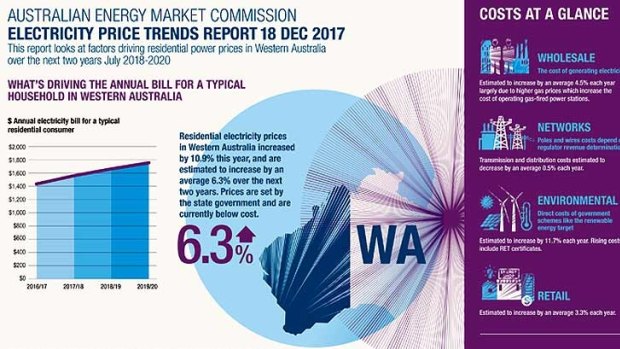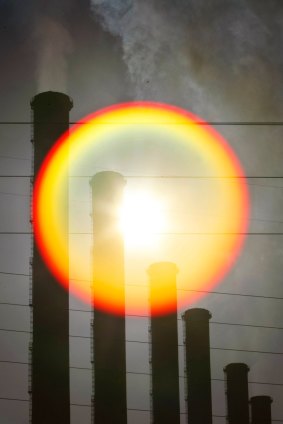This was published 6 years ago
WA's electricity prices to rise while the rest of Australia enjoys savings
By Daile Cross and Cole Latimer
Western Australia, the Northern Territory and the ACT will continue to see electricity price increases while the rest of the country enjoys price reductions, with WA forecast to experience a 6.5 per cent jump in current energy bills.
In its latest electricity trends report, the Australia Energy Market Commission predicts prices across the country will rise sharply in the first quarter of 2018 before falling by 6.2 per cent each year on average over the next two years from July thanks to falling wholesale energy costs.

WA prices at a glance. Credit: AEMC
AEMC Chairman John Pierce said prices paid by WA consumers were set by the WA government, which subsidised electricity prices. Residential prices were now less than the cost of supply.
But he said an analysis of underlying drivers found there was likely to be an increase in wholesale costs, which made up around 40 per cent of a typical bill.

A record-breaking high in the March 2018 summer quarter is forecast to be the peak for energy bills.Credit: MICK TSIKAS
"Residential electricity prices in Western Australia are estimated to rise by 6.3 per cent on average for each of the next two years," Mr Pierce said.
"Underlying this is an estimated annual increase of 4.5 per cent in wholesale costs, driven by higher gas prices which increase the cost of operating gas-fired generators."
In 2016-17, a representative Western Australian family, using ing 5198 kWh per year paid a total annual bill of $1412 exclusive of GST. This was less than the total cost of supply of $1580.
WA Treasurer Ben Wyatt told Radio 6PR there was nothing new in the report released on Monday.
"There is nothing for people to be alarmed about," he said.
The east coast of the country had seen erratic movement in energy prices, Mr Wyatt said. This was not the case in WA.
Earlier in the year the WA State Government announced a raft of measures to help repair the state budget, with an increase of $169 to the fixed charge component of electricity bills, or 10.9 per cent for the representative household included.
Mr Wyatt said there would not be any further price increases in this week's mid-year review.
But the government would have to look at electricity in the next budget.
Opposition spokesman Dean Nalder said more competition needed to be introduced into the market and this would see competition on prices.
The downward price pressure experienced on the east coast would be welcomed by consumers in WA, he said.
Victoria is expected to see the greatest change in its electricity bills, with power prices falling 8.2 per cent between July 2018 and 2020.
But average annual bills in Victoria this financial year are tipped to be 15.9 per cent higher, driven by the wholesale electricity price, the state's first summer without the Hazelwood coal-fired power plant, and a higher gas price, which increased the cost of operating gas-fired generators.
Annual electricity bills for Victorians will peak this current financial year at around $1275 for an average residential user. By the 2019-20 financial year, bills will drop to an average of $1075.
South Australia and Queensland will see a similar drop in price of 7.3 and 7.1 per cent respectively from the middle of next year.
This will be welcome news for South Australians, who have some of the highest energy bills in the world, and are seeing a 17 per cent increase in annual average electricity costs, which will peak this financial year at nearly $1900.
NSW and Tasmania are expected to have the smallest reduction in future prices, with declines of 6.6 and 6.5 per cent respectively from the middle of next year.
But annual electricity bills in NSW are forecast to be 10.2 per cent higher for the current 2017-18 period compared to last year, reaching close to an annual total of $1300 for an average residential user. They are expected to fall to an average annual rate of $1125 for the 2019-20 financial year.
Despite these forecast prices falls, the AEMC said the government must continue to refine its energy policies to ensure these price reductions occurred.
“Right now we’re seeing the whole power system transforming, so it’s going to be cleaner, with more new technologies like batteries, but we have to make sure this market transformation works,” the AEMC said.
It forecast that around 5.3 gigawatts of new power would come online between 2016-17 and 2019-20, the majority of which – about 4.9 gigawatts – would be renewable generation, which would help drive down energy costs in the medium-term.
“We know more wind and solar supply will help bring prices down, but old power stations are starting to close down, which means supply will drop and prices go up again,” an AEMC spokeswoman said.
“Without investment in replacement dispatchable capacity, wholesale prices will go up again and remain volatile. And the rollercoaster will be repeated. If it’s not managed the right way you can get more system instability and blackouts.”